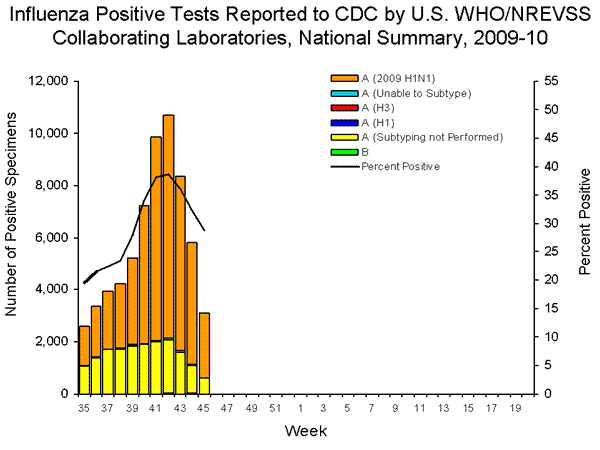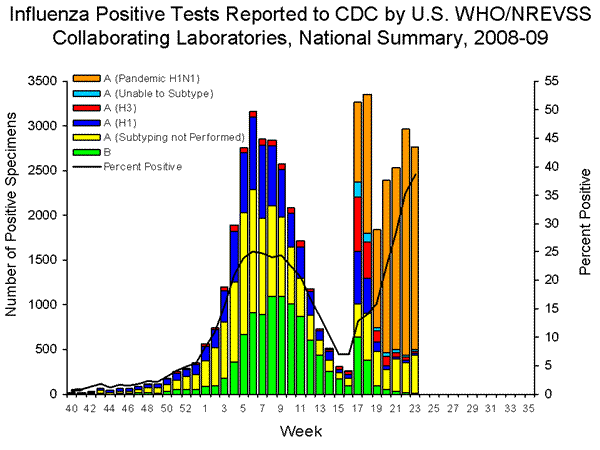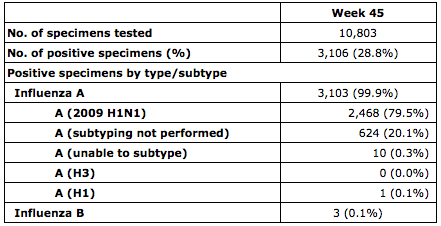As week 46 of 2009 comes to a close, the Centers for Disease Control and Prevention reports that influenza has peaked in the US. That conclusion is based on the agency’s influenza surveillance program, summarized in this figure:


Does this mean that pandemic influenza is over? Absolutely not. This is just the second wave, sparked when school began in the fall. Recall the the first wave of H1N1 infections that took place during the spring and summer:


It’s interesting to note that seasonal H1N1 and H3N2 strains are nearly gone. Of the 10,803 specimens tested by the CDC during week 45, 3,106 were confirmed as novel H1N1, one was seasonal H1N1, and no H3N2 strain was detected.


There will be more influenza to come in the winter. A catalyst might be increased travel as we come upon the holiday season. This NY Times article has a good summary of the current state of influenza and what we might expect.
Note added a few days later: Despite dire predictions to the contrary, the 2009 swine-origin H1N1 influenza virus has not mutated to increased virulence from the first to the second wave of infection. As I’ve written before, there is no evidence from any influenza pandemic that viral mutants of increased virulence in humans have emerged in successive cycles of infection.

Some mathematical biologists at Purdue made a pretty impressive prediction of a 42nd week peak, back in September:
http://www.eurosurveillance.org/ViewArticle.asp…
They did a fit using a seasonally-driven SIR model and the CDC data from weeks 22-33. They don't show what that fit does in the coming spring…
I agree there will be another peak of flu in the Spring, but I imagine it will be seasonal.
Couldn't there have been a lot more swine flu around in the beginning of the year from, say, week 1 through 12? I'm looking at all those “A (Subtyping not Performed)”, for instance, and wondering how many (if any) were swine flu.
It is possible that some 2009 H1N1 virus was circulating early in
2009; in fact sequence analysis suggests that the virus originated
towards the end of 2008. However I believe it's likely the strain
would have been detected. Even though many strains are not subtyped,
enough of the swine-origin virus would have cropped up as 'untypable'
to warrant further analysis. Which is what happened in California and
Texas in April 2009.
I was wondering what is the reason for seasonal H1N1 and H3N2 infection diminishes so dramatically as the pandemic H1N1 prevailing? Is it because the pandemic H1N1 are more infective than the others? If the pandemic H1N1 and other strains infect a person simultaneously, would the pandemic H1N1 out-grow the other strains?
That is a great question which no one has ever been able to answer.
It's been seen before. For example, in 1957, when the H2N2 pandemic
strain emerged, the H1N1 strains that had been circulating since 1918
disappeared. In 1968, when the pandemic H3N2 strain emerged, the H2N2
strains went away. One idea is 'antigenic sin', which says that when
the new strain emerges, it stimulates a strong memory response to
influenza viruses that have previously infected the host. But it's not
clear if that explains everything.
If this is the case, would it mean that the vaccination against other strains could render people more susceptible to newly emerging “novel” strain?
That's never been shown to be a consequence of original antigenic sin.
If immunization is against antigenically distinct strains one would
simply expect that the new strain would not be recognized by the
memory response. No reason to believe infection with the novel strain
would be worse.
Hi,
Could you point me to a reference for this? I've never heard it before, and given that we've only had 4-5 pandemics in the past century it seems surprising that you can be so confident. It's not at all consistent with the 1918 influenza in the US, and I'm not aware of anything showing such waves for the 1957, 1968, or 1977 pandemics. I know of the 2006 Science paper showing waves in normal seasonal flu (6-7 week waves for H1N1, 3-4 weeks for H3N2) but that's quite a different thing, not reflecting national incidence.
Hi,
Could you point me to a reference for this? I've never heard it before, and given that we've only had 4-5 pandemics in the past century it seems surprising that you can be so confident. It's not at all consistent with the 1918 influenza in the US, and I'm not aware of anything showing such waves for the 1957, 1968, or 1977 pandemics. I know of the 2006 Science paper showing waves in normal seasonal flu (6-7 week waves for H1N1, 3-4 weeks for H3N2) but that's quite a different thing, not reflecting national incidence.
Pingback: H1n1 Recall